Sustainable Swimwear Market Research, 2032
The global sustainable swimwear market size was valued at $7.8 billion in 2022, and is projected to reach $16.2 billion by 2032, growing at a CAGR of 7.7% from 2023 to 2032.
Manufacturing sustainable swimwear involves sourcing of materials from recycled or renewable sources, minimizing waste in production processes, and considering ethical labor practices. Sustainable swimwear aims to reduce the environmental impact of traditional swimwear production, which often relies on petroleum-based materials and contributes to pollution and resource depletion.
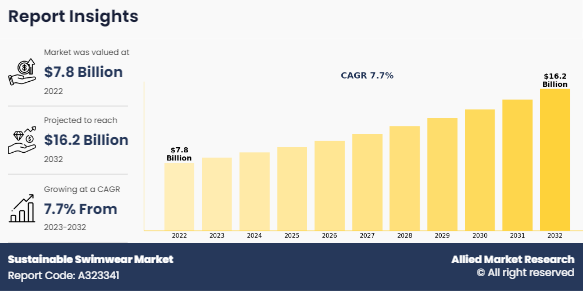
The fashion industry, including swimwear, is increasingly acknowledging the imperative to adopt sustainable practices. Owing to growing awareness regarding environmental concerns and consumer demand for ethically-produced garments, the swimwear sector is undergoing a transformation towards eco-friendly options. Sustainable swimwear not only addresses environmental issues but also embraces social responsibility.
Key Takeaways
- Based on material type, the repreve sub-segment emerged as the global leader in 2022 and is anticipated to be the fastest growing during the forecast period.
- Based on end user, the women sub-segment emerged as the global leader in 2022 and is predicted to show the fastest growth in the upcoming years.
- Based on application, the leisure sub-segment emerged as the global leader in 2022 and the sports sub-segment is predicted to show the fastest growth in the upcoming years.
- Based on distribution channel, the offline sub-segment emerged as the global leader in 2022 and the online sub-segment is predicted to show the fastest growth in the upcoming years.
- Based on region, North America registered the highest market share in 2022 and Europe is projected to show the fastest growth during the forecast period.
Segment Overview
The sustainable swimwear market is segmented into Material Type, End User, Application and Distribution Channel.
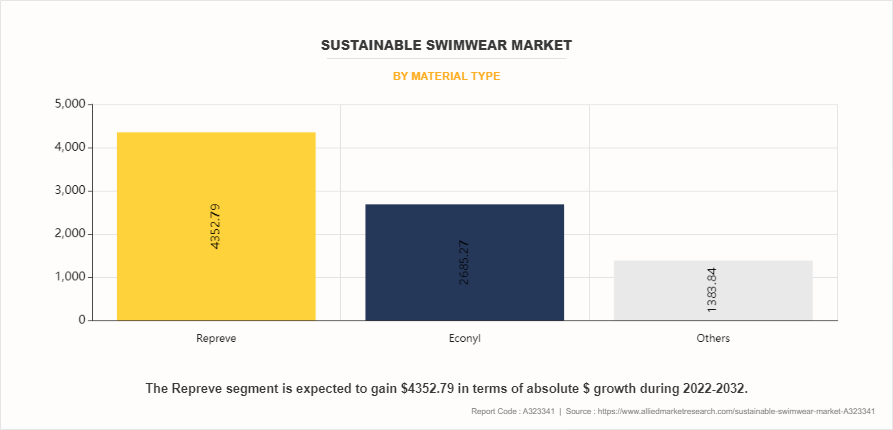
By material type, the repreve sub-segment dominated the global sustainable swimwear market demand in 2022. Repreve, an innovative recycled polyester fabric, is experiencing a surge in demand and popularity within the fashion industry, particularly in the activewear and sportswear segments. Its rise can be attributed to several factors driving consumer preference. Firstly, as sustainability becomes increasingly important, consumers are actively seeking eco-friendly alternatives. Repreve’s utilization of recycled materials, particularly post-consumer plastic bottles, resonates with environmentally conscious consumers who prioritize reducing plastic waste and lowering carbon footprints.
In addition, repreve’s performance attributes make it an attractive choice for activewear. Its water-repellent, strong, resilient, stretchy, and lightweight properties align well with the demands of athletic activities, appealing to athletes and fitness enthusiasts who seek both sustainability and functionality in their clothing. These factors are anticipated to have a positive impact on the repreve sub-segment of the sustainable swimwear market during the forecast years.
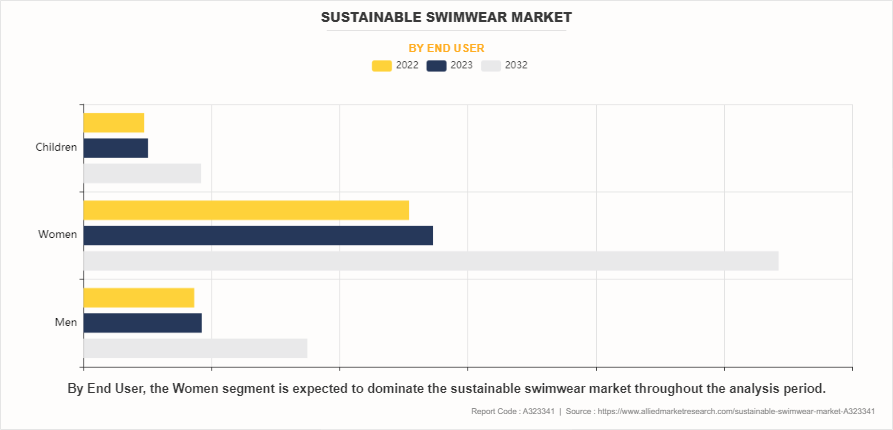
By end user, the women sub-segment dominated the global sustainable swimwear market statistics in 2022. Women tend to purchase swimwear more frequently than men due to a variety of factors, including fashion trends, body image, and social expectations. Swimwear for women offers a wide range of options, catering to diverse preferences, body shapes, and style preferences. This extensive selection allows women to express their individuality and feel confident and comfortable while enjoying water-related activities.
Moreover, women's swimwear options are often more varied and creative compared to men's, with styles ranging from bikinis and one-pieces to tankinis and swim dresses. This diversity allows women to choose swimwear that suits their personal style, body type, and level of modesty, further contributing to the popularity of women's swimwear purchases.
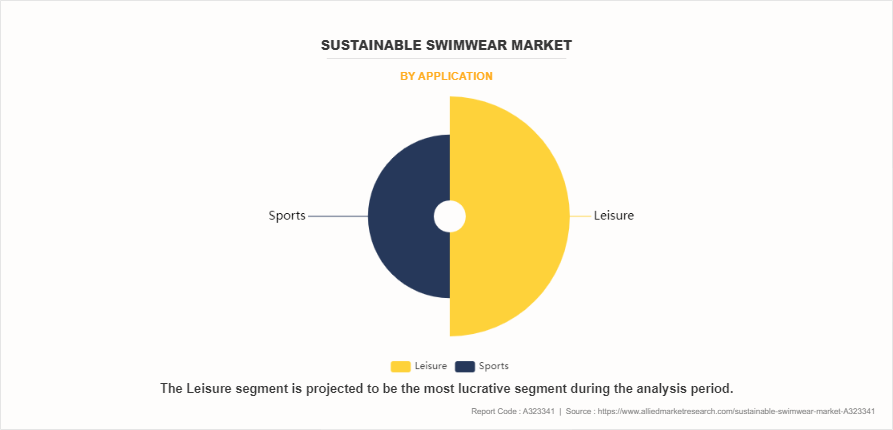
By application, the leisure activities sub-segment dominated the global market share in 2022. Sustainable swimwear has gained popularity for leisure activities such as beach outings, pool parties, water sports, and tropical vacations often involve spending extended periods in swimwear, making comfort, durability, and style essential considerations. Sustainable swimwear addresses these needs by offering garments made from eco-friendly materials like recycled plastics, organic cotton, and bamboo viscose, which reduce environmental impact compared to traditional swimwear fabrics. The versatility and performance of sustainable swimwear make it well-suited for a range of leisure activities.
Whether lounging by the pool, playing beach volleyball, snorkeling in coral reefs, or paddleboarding on serene lakes, sustainable swimwear provides comfort, support, and freedom of movement. Its moisture-wicking properties keep wearers dry and comfortable, while its durability ensures longevity, even in challenging aquatic environments.
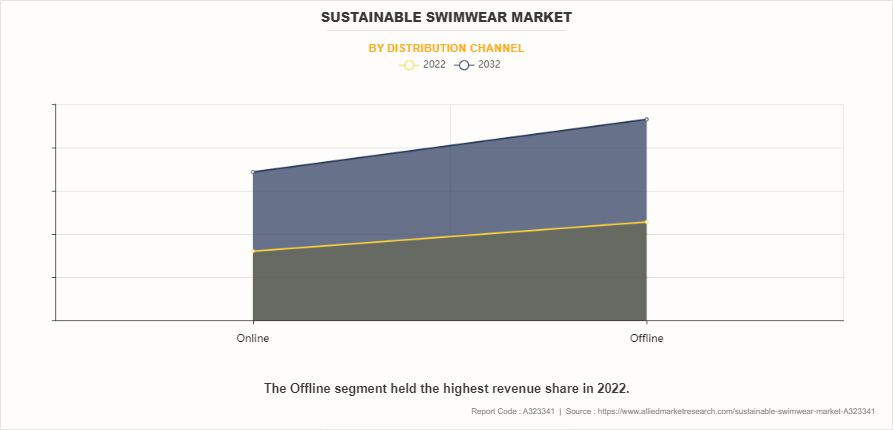
By distribution channel, the offline sub-segment dominated the global market share in 2022. Offline shopping for sustainable swimwear is also facilitated by various stores that prioritize eco-conscious fashion. Among these are retail giants like REI and Nordstrom, which stock a range of sustainable swimwear brands in their physical stores. By offering offline shopping, these stores provide customers with the opportunity to experience the swimwear firsthand, ensuring proper fit and quality. In addition, offline shopping at these stores allows customers to benefit from personalized assistance from knowledgeable staff, who can offer guidance on sustainable fashion choices and styling tips.
Furthermore, offline shopping at specialty stores like Athleta and prAna allows customers to explore a curated selection of sustainable swimwear options in a dedicated environment. These stores often host events and workshops focused on sustainability, fostering community engagement and education around eco-friendly fashion practices. Overall, offline shopping at these global brands and stores offers the convenience of physical exploration along with the assurance of sustainable and ethically sourced swimwear options.
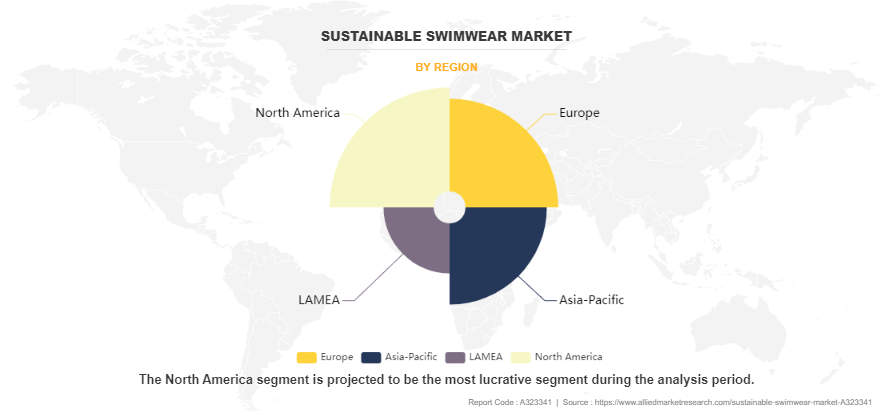
By region, North America dominated the global sustainable swimwear market in 2022. North America, particularly the U.S., has emerged as a hub for sustainable swimwear due to several factors. Firstly, there is a growing awareness and demand for eco-friendly fashion among consumers in North American countries, driven by increasing environmental consciousness and a desire to support ethical and sustainable brands. In addition, the region is home to a vibrant fashion industry that fosters innovation and creativity, making it conducive to the development and promotion of sustainable swimwear brands.
Several top sustainable swimwear brands in North America, offering a combination of style, quality, and eco-consciousness are Summersalt, renowned for its use of recycled materials and inclusive sizing options, and Outerknown, founded by champion surfer Kelly Slater, which prioritizes sustainable practices throughout its supply chain. Similarly, brands like Vitamin A and Mara Hoffman are renowned for their commitment toward sustainability, incorporating recycled fabrics and responsible production methods into their swimwear collections.
Competitive Analysis
The key players profiled in the sustainable swimwear market report include SUMMERSALT, Patagonia, Inc., Vitamin A., Londre Bodywear, TomboyX, Reformation, Andie Swim, Boden US, Youswim Limited, and REY SWIMWEAR. Technological advancement, product launch, partnership, and business expansion are the key strategies adopted by the market players. For instance, in February 2024, Arena, a prominent swimwear brand, achieved faster and more sustainable prototyping by leveraging Dassault Systèmes' 3DEXPERIENCE Works. By utilizing real-time collaboration and simulation capabilities, Arena has optimized its design processes, delivering higher quality products to customers in a shorter time frame. The move highlights the brand's commitment toward innovation and sustainability within the sport lifestyle segment.
Market Dynamics
Increasing awareness regarding the environmental impact of traditional swimwear materials, such as petroleum-based spandex, has prompted consumers to seek alternatives that minimize harm to the environment. In addition, the regulations and policies aimed at reducing environmental pollution and promoting sustainable practices in the fashion industry are putting pressure on swimwear manufacturers to adopt more eco-friendly approaches. For instance, regulations such as the European Union's REACH (Registration, Evaluation, Authorization, and Restriction of Chemicals) aim to ensure the safe use of chemicals in the textile industry, reducing the environmental and health risks associated with hazardous substances. In addition, the Global Organic Textile Standard (GOTS), which certifies organic fibers, and the Bluesign system, which assesses and manages the environmental impact of textile production is anticipated to boost the sustainable swimwear market share in the upcoming years.
Sustainable swimwear often comes with a higher price tag compared to conventional options, posing a financial challenge for consumers who prioritize affordability. In addition, the selection of sustainable swimwear is limited compared to mainstream options, restricting consumer choices and accessibility. In addition, sustainable swimwear brands face longer production times due to their commitment toward ethical labor practices and environmentally-friendly processes, which hinders their ability to meet consumer demand quickly. These factors are anticipated to restrain the sustainable swimwear market growth in the upcoming years.
The growing demand for eco-friendly alternatives and the increasing awareness regarding the environmental impact of traditional swimwear materials is anticipated to generate excellent opportunities in the sustainable swimwear industry. For instance, the development and use of advanced sustainable materials like econyl and recycled polyester has attracted large number of sustainable swimwear manufacturers. This is because the sustainable swimwear brands can leverage these materials to create durable and stylish swimwear while reducing their reliance on virgin resources and minimizing waste. In addition, there is scope for brands to enhance transparency and ethical practices throughout their supply chains. By prioritizing fair wages, safe working conditions, and environmentally sound production methods, brands can build trust with consumers who are seeking genuinely sustainable options. These factors are anticipated to have a positive impact on the sustainable swimwear market forecast.
Key Benefits For Stakeholders
- This report provides a quantitative analysis of the market segments, current trends, estimations, and dynamics of the sustainable swimwear market analysis from 2022 to 2032 to identify the prevailing sustainable swimwear market opportunities.
- The market research is offered along with information related to key drivers, restraints, and opportunities.
- Porter's five forces analysis highlights the potency of buyers and suppliers to enable stakeholders make profit-oriented business decisions and strengthen their supplier-buyer network.
- In-depth analysis of the sustainable swimwear market segmentation assists to determine the prevailing market opportunities.
- Major countries in each region are mapped according to their revenue contribution to the global market.
- Market player positioning facilitates benchmarking and provides a clear understanding of the present position of the market players.
- The report includes the analysis of the regional as well as global sustainable swimwear market trends, key players, market segments, application areas, and market growth strategies.
Sustainable Swimwear Market Report Highlights
| Aspects | Details |
| Market Size By 2032 | USD 16.2 billion |
| Growth Rate | CAGR of 7.7% |
| Forecast period | 2022 - 2032 |
| Report Pages | 320 |
| By Material Type |
|
| By End User |
|
| By Application |
|
| By Distribution Channel |
|
| By Region |
|
| Key Market Players | TomboyX, Andie Swim, Londre Bodywear, Patagonia, Inc., Youswim Limited, Boden US, Reformation, Vitamin A., SUMMERSALT, REY SWIMWEAR |
The global sustainable swimwear market is driven by increasing environmental consciousness among consumers. Opportunities lie in innovative designs, technological advancements in eco-friendly fabrics, and collaborations fostering sustainability across the supply chain.
The major growth strategies adopted by the sustainable swimwear market players are partnership, business expansion, and product launch.
Europe will provide more business opportunities for the global sustainable swimwear market in the future.
SUMMERSALT, Patagonia, Inc., Vitamin A., Londre Bodywear, TomboyX, Reformation, Andie Swim, Boden US, Youswim Limited, and REY SWIMWEAR. are the major players in the sustainable swimwear market.
The repreve sub-segment of the type segment acquired the maximum share of the global sustainable swimwear market in 2022.
The potential customers of the sustainable swimwear market include eco-conscious travelers, fitness enthusiasts, and people who like exploring beaches.
Growing emphasis on ethical and transparent supply chains, adoption of minimalist and versatile designs in swimwear, and incorporation of reversible and mix-and-match pieces for swimwear are the current trends in the market.
Loading Table Of Content...
Loading Research Methodology...



